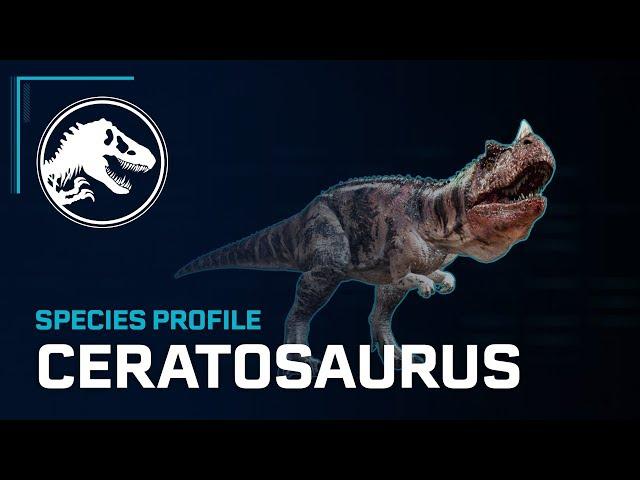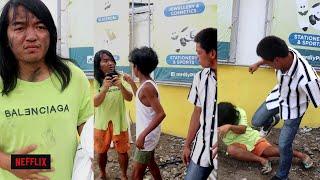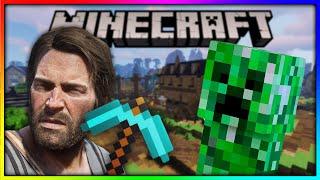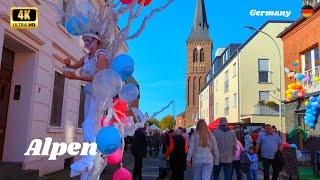
Species Profile - Ceratosaurus
Комментарии:

Ingen Ankylosaurus size
9.6 meters (31.5 feet)

Ingen male ceratosaurus size
7 meters (23 feet)

Ceratosaurus family
Ceratosauridae

Ceratosaurus male bigger than female
Ответить
Ankylosaurus female bigger than male
Ответить
ALL DINOSAURS
CERATOSAURUS
ANKYLOSAURUS

i wish i had sharp teeth like him
Ответить
best dino
Ответить
I was trying to hear the sound it made you idiots! The stupid ai bitch talked over the whole thing 😂🤣
Ответить
so yucky
Ответить
😊😊😊😅
Ответить
Ladies and gentlemen, we wish to announce that the Jurassic carnivore, Ceratosaurus, is now on display. Please enjoyJane Powers
Ответить
I heard this dinosaur appeared in Jurassic world camp Cretaceous season 2
Ответить
ceratosaurus
Ответить
Such an underrated game
Ответить
I have a fanfiction where Cedar Wood from Ever After High can turn herself into one of these
Ответить
Rrrgraaaatatataaa!
Ответить
LOOK THE CERATOSAURUS IS DOING SOMETHING
Ответить
Cerater The Ceratosaurus
Ответить
Did Ceratosaurus is part of Tyranosaurus family? Because this horned theropod similar to Proceratosaurus is member of Tyranosaurus family
Ответить
Hi
Ответить
This species is back from Jurassic Park 3
Ответить
케라토사우루스
Ответить
Species Profile - Ceratosaurus
Ответить
A carnivore with three horns. It has four fingers and some armor on its back
Dr Taylor-Dinosaur King

Lies
Ответить
This dinosaur is one of the only known theropods with osteoderms, or bone armor that grew inside the skin
Ответить
Ceratosaurus-Horned Lizard-North America
Ответить
It’s back from JP3!!
Ответить
Will it smell Spinosaurus poop?
Ответить
I saw that Dino in the third movie of Jurassic Park!
Ответить
I also want diplocus and parasaursolpu's family:muttbuttsaur,anotatin,fix edmontosaur.patchy's family:drakorex,stiggymolch.giantoraptor, oviraptor.
Ответить
As well as...utahrptor,fix dineochus,carnotaur's profile and triceratop's family:torosaur and pachyrhinosaur
Ответить
Hey JW Evolotion, do majangasaur,allosaur,camrasaur,giga and crylopasaur
Ответить
The ceratosaurus’ roar in game is the coolest thing I’ve ever heard
Ответить
My favourite dinosaur! :D
Ответить
That’s what the poop from Jurassic Park 3 gets for leaving so the Ceratosaurus has no more screen time
Ответить
Fun fact: JP Ceratosaurus was created partially from T Rex DNA. It's like a whey protein of T Rex's cheese
Ответить
It’s the first carnivore we see
Ответить
Why is Ceratosaurus soo big in this game?
Ответить
Me fav carnivore.
Ответить
jp 3 ceratosaurus comeback!
Ответить
One of InGen's first few illegally created dinosaurs after the Gene Guard Act. Other dinos are Corythosaurus, Ankylosaurus, and of course Spinosaurus.
Ответить
at least they sound better here then they did in Operation Genesis
Ответить
EXTRACTING SPECIES PROFILE...
__
A-Z LIST:
Ceratosaurus
Triceratops
----
ORDER OF RELEASE LIST:
Triceratops
Ceratosaurus

I’m going to pre order it no matter what happens
Ответить
Damn the broken wrists are the best
Ответить
So hyped!!!
Ответить
Ceratosaurus (from Greek κέρας/κέρατος, keras/keratos meaning "horn" and σαῦρος/sauros meaning "lizard"), was a large predatory theropod dinosaur from the Late Jurassic Period (Oxfordian to Tithonian), found in the Morrison Formation of North America, and the Lourinhã Formation of Portugal (and possibly the Tendaguru Formation in Tanzania). It was characterized by large jaws with blade-like teeth, a large, blade-like horn on the snout and a pair of hornlets over the eyes. The forelimbs were powerfully built but very short. The bones of the sacrum were fused (synsacrum) and the pelvic bones were fused together and to this structure (i.e. similar to modern birds). A row of small osteoderms was present down the middle of the back.
*Species:
*Ceratosaurus nasicornis: (meaning "rhinoceros horned reptile"), 5.3-6 m (17-20 ft) and 418-670 kg (922-1,480 lbs). Fossil remains: Two skulls and some skeletons including a juvenile. Anatomical characteristics: Head large, long, rectangular, narrow; large, narrow nasal horn, orbital hornlets large, subtriangular; teeth large. Tail deep, and heavy. Arm and hand short. Leg not long. Single row of small, bony scales along back. Age: Late Oxfordian to early Tithonian. Distribution and formations: Colorado, Utah; lower and middle Morrison. Habitat: Short wet season, otherwise semiarid with open floodplain prairies and riverine forests. Habits: Ambush predators. Large bladed teeth indicate that this animal hunted large prey including sauropods and stegosaurs by delivering slashing wounds and that the head was a much more important weapon than the small arms. Deep tail may have been used as sculling organs while swimming. Nasal horn probably for display and head butting within the species. Notes: The species C. magnicornis is so similar that it appears to be a member of C. nasicornis, or it may represent a descendant of C. nasicornis. Ceratosaurus shared its habitat with the much more common, faster Allosaurus and similarly uncommon, stouter Torvosaurus.
*Ceratosaurus dentisulcatus: (meaning "furrowed teeth, horned reptile"), 7-8.83 m (21-29 ft) and 452-700 kg (996-1,500 lbs). Fossil remains: Part of a skull and skeleton. Anatomical characteristics: Head deeper, lower jaw not as curved, and teeth not as proportionally large as C. nasicornis. Age: Late Juraasic, middle Tithonian. Distribution and formation: Utah; upper Morrison. Habitat: Wetter than earlier Morrison, otherwise semiarid with open floodplain prairies and riverine forests. Habits: similar to C. nasicornis. Notes: It is not certain whether C. dentisulcatus had a nasal horn or not. May be a descendant of C. nasicornis. Shared its habitat with later species of Allosaurus.
*Ceratosaurus unnamed species: 6 m (20 ft) and 600 kg (1,300 lbs). Fossil remains: Minority of skeleton. Anatomical characteristics: Insufficient information. Age: Late Jurassic, Tithonian. Distribution and formation: Portugal; Lourinha. Habitat: Large, seasonally dry island with open woodlands. Notes: Assignment by some researchers of this specimen to C. dentisulcatus is not certain.
*Description: Ceratosaurus followed the bauplan typical for large theropod dinosaurs. A biped, it moved on powerful hind legs, while its arms were reduced in size. The holotype specimen was an individual about 5.3 metres (17 ft) long; it is not clear whether this animal was fully grown. Marsh (1884) suggested that the holotype individual weighed about half as much as Allosaurus. In more recent accounts, it was estimated at 418 kilograms (922 lb), 524 kilograms (1,155 lb) and 670 kilograms (1,480 lb) by separate authors. Two skeletons, assigned to the new species C. magnicornis and C. dentisulcatus by James H. Madsen and Samuel P. Welles in a 2000 monograph, were substantially larger than the holotype. The larger of these, C. dentisuclatus, was informally estimated by Madsen to have been around 8.8 metres (29 ft) long. American science writer Gregory S. Paul, in 1988, estimated the C. dentisulcatus specimen at 980 kilograms (2,160 lb). A considerably lower figure, 275 kilograms (606 lb) for C. magnicornis and 452 kilograms (996 lb) for C. dentisulcatus, was proposed by John Foster in 2007. The exact number of vertebrae is unknown due to several gaps in the holotype's spine. At least 20 vertebrae formed the spine of the neck and back in front of the sacrum. The bodies of the cervical (neck) vertebrae were as long as tall in the middle portion of the neck but became shorter in both the front and rearward portion. The upwards projecting spinous processes were comparatively large, and, in the dorsal (back) vertebrae, were as tall as the vertebral bodies were long. The sacrum, consisting of 6 fused sacral vertebrae, was arched upwards, with its vertebral bodies strongly reduced in height in its middle portion, as is the case in some other ceratosaurians. The tail comprised around 50 caudal vertebrae and was about half of the animal's total length; Gilmore reconstructed it at 9.33 feet (2.84 m) for the holotype. Characterized by high spinous processes and elongated chevrons (bones located below the caudal vertebrae), the tail was deep in lateral profile. As in other dinosaurs, it counterbalanced the body and contained the massive caudofemoralis muscle, which was responsible for forward thrust during locomotion, pulling the upper thigh backwards when contracted.
*Skull: The skull was quite large in proportion to the rest of its body. It measures 62.5 cm in length in the holotype, while the fairly complete skull of C. magnicornis was estimated to have been 60 cm in length and 16 cm in width; this skull was somewhat longer and lower than the holotype skull. The back of the skull is very lightly built compared to other larger theropods due to extensive skull openings, yet the jaws were deep to support the proportionally large teeth. The lacrimal bone does not only form the back margin of the antorbital fenestra (a large opening between eye and nostril), but also part of its upper margin, unlike in abelisaurids. The quadrate bone, which at its bottom end is connected to the lower jaw to form the jaw joint, is inclined so that the jaw joint is displaced backwards in relation to the occipital condyle of the braincase, which connects to the first neck vertebra. This also lead to a broadening of the base of the lateral temporal fenestra, a large opening behind the eyes. The most distinctive feature of the skull was a prominent horn, which was situated on the skull midline behind the nostrils and was formed from co-ossified protuberances of the left and right nasal bones. Only the bony horn core is known from fossils – in the living animal, this core would have supported a keratinous sheath. In the holotype specimen, the horn core is 13 centimetres (5.1 in) long and 2 centimetres (0.79 in) wide at its base but quickly narrows down to only 1.2 centimetres (0.47 in) further up; it is 7 centimetres (2.8 in) in height. It is longer and lower in the C. magnicornis skull. Behind the nasal horn, the nasal bones form an oval groove; both this groove and the nasal horn serve as features to distinguish Ceratosaurus from related genera. In addition to the large nasal horn, Ceratosaurus possessed smaller, semicircular, hornlike ridges in front of each eye, similar to those of Allosaurus; these ridges were formed by the lacrimal bones. In juveniles, all three horns were smaller than in adults, and the two halves of the nasal horn core were not yet co-ossified.
*History of discovery: In an 1892 paper, Marsh published the first skeletal reconstruction of Ceratosaurus, which depicts the animal at 22 feet (6.7 m) in length and 12 feet (3.7 m) in height. As noted by Gilmore in 1920, the trunk was depicted much too long in this reconstruction, incorporating at least six supernumerary dorsal vertebrae. This error was repeated in several subsequent publications, including the first life reconstruction, which was drawn in 1899 by Frank Bond under the guidance of Charles R. Knight but not published until 1920. A more accurate life reconstruction, published in 1901, was produced by J. M. Gleeson, again under Knight's supervision. The holotype specimen was mounted by Gilmore in 1910 and 1911 and since was on exhibit at the National Museum of Natural History in Washington, D.C.. Most early reconstructions show Ceratosaurus in an upright posture, with the tail dragged over the ground. Gilmore's mount of the original holotype fossil, in contrast, was ahead of its time. Inspired by the upper thigh bones, which were found angled against the lower leg, he depicted the mount as a running animal with a horizontal rather than upright posture and a tail which did not make contact with the ground. Because of the strong flattening of the fossils, Gilmore mounted the specimen not as free-standing skeleton but as a basrelief within an artificial wall. With the bones being partly embedded in plaque, scientific access was limited. In the course of the renovation of the museum's dinosaur exhibition between 2014 and 2019, the specimen was dismantled and freed from encasing plaque. In the new exhibition, which is set to open in 2019, the mount is planned to be replaced by a free-standing cast, and the original bones to be stored in the museum collection to allow for full access to scientists.

If I had to guess I would think that carnotaurus will be in game. If so I'm definitely putting these guys in the same enclosure with them!
Ответить



![DysleX AfroEDM Fridays Ep031 [Rema Special] DysleX AfroEDM Fridays Ep031 [Rema Special]](https://ruvideo.cc/img/upload/c18zQmM2VU9BV08.jpg)
![NAUEL - Bien [Video Oficial] NAUEL - Bien [Video Oficial]](https://ruvideo.cc/img/upload/NE4wSVgxa2xYUkk.jpg)




















